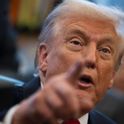Just days before the opening of this year’s COP29 climate conference in Azerbaijan, and towards the end of a year marked by climate disasters and the highest global temperatures in human history, analysts, activists, investors and political leaders are scrambling to respond to the imminent return of Donald Trump to the White House. Here is a man who calls climate change a “hoax,” and who will once again have the power to undermine national and global efforts to avoid climate catastrophe.
The United States is the world’s second-biggest emitter of planet-warming gases, but its record on climate commitment has always been volatile and unreliable. Under President Bush Sr, the US negotiated and signed the founding treaty on climate action, the United Nations Framework Convention on Climate Change (UNFCCC), in 1992. Bill Clinton signed up to the Kyoto Protocol in 1998 but never sent it to the Senate for ratification. Barack Obama became active on climate in his second term and put diplomatic effort behind the Paris agreement, designed as an accord so that the US president could sign up to it without congressional approval. The Paris agreement was adopted in December 2015 and came into force nearly a year later, just as Trump was elected president. He promptly withdrew, claiming—falsely—that it imposed an unfair burden on the US. In Trump’s first term, America became the world’s biggest producer of both oil and gas.
The US withdrawal from the Paris agreement was a diplomatic gift to China’s leader, Xi Jinping, who wasted no time in staking China’s claim to climate responsibility and leadership. It did not, however, bring US efforts on climate to a complete standstill. Given the difficulty of getting climate legislation through congress, Obama had enacted climate policy through executive orders and regulation. The Environmental Protection Agency (EPA), for example, was given power to regulate carbon emissions as a pollutant, and the administration had vigorously defended its regulations against legal attacks from the fossil fuel industry. This legal defence culminated in the 2007 Supreme Court ruling that greenhouse gases fall within the Clean Air Act’s definition of an air pollutant, and therefore could be regulated.
Under the first Trump administration the legal challenges came from climate defenders. President Obama had launched a Clean Power Plan that aimed to reduce CO2 emissions from the power sector and banned new coal plants that did not capture their carbon. It had faced constant legal challenge and when Trump came to power he replaced the Clean Power Plan with the much weaker Affordable Clean Energy Rule; he also weakened vehicle fuel economy standards and removed California’s power to set its own fuel economy rules, as it had since 1970—and even earlier. The Trump administration also relaxed rules limiting venting and flaring of highly damaging methane emissions from oil and gas production, as well as on the requirement to report on such emissions. He lifted bans on oil and gas exploration in the Arctic National Wildlife Refuge and parts of the National Petroleum Reserve in Alaska, in coastal waters and in protected National Monuments in Utah. All these measures, and others that reduced protection from air and water pollution, were challenged, often successfully, in court.
Today, however, US federal courts are more heavily influenced by Trump appointees: he secured 234 lifetime judicial appointments during his first term. Republican control of the senate in the coming administration will allow him both to fill any supreme court vacancies and to extend further his influence on the federal judiciary.
Trump substantially weakened and delayed both climate and environmental action through other measures, too. He made it harder for US investment firms to invest in pension funds with environmental, social and governance priorities—described in his recent election campaign as “woke financial scams”. Indeed, false claims and the denigration of science were fundamental to Trump’s attack on climate policy. According to the Silencing Science Tracker—an online database which records anti-science actions taken by the US federal, state and local governments—the Trump presidency changed how federal government agencies used and communicated scientific research and engendered mistrust by claiming that climate scientists were a cabal whose actions could be explained either by ideology or money. The tracker documents 346 anti-science actions by the federal government between November 2016 and January 2021, including censorship, budget cuts, personnel changes, research hindrance and misrepresentation.
In his 2024 campaign, to which the fossil fuel industry contributed generously, Trump’s climate claims became even more unhinged, ranging from incoherent stories about sharks and electric batteries to claims that wind turbines are driving whales to suicide. He has promised to “drill, baby drill”, to withdraw, once again, from the Paris agreement, and to dismantle the climate-friendly policies of his predecessor, Joe Biden. Some of his more extreme advisers advocate leaving the UNFCCC entirely.
The Trump presidency will undoubtedly damage global climate efforts. They will do so at a time when the world needs urgently to ramp those efforts up in order to avoid tipping over into climate breakdown with catastrophic consequences. The new administration will undermine diplomatic efforts and give an excuse to other laggards and hostile states to slacken off.
At home, too, Trump will do a great deal of damage to US science, climate innovation and competitiveness—but he may find it harder than he claims to undo all of Biden’s policies. These include the Infrastructure Investment and Jobs Act (or Bipartisan Infrastructure Law), passed in 2021, and the Inflation Reduction Act (IRA), passed in August 2022. It was the largest piece of climate legislation in US history and established a comprehensive set of clean energy incentives including tax credits for electric vehicles (EVs), direct air capture and sequestration of carbon dioxide. It also enabled the investment of hundreds of billions of dollars in clean energy, EVs and environmental justice.
Biden’s administration did not limit oil and gas production, both of which soared under his presidency. Instead, he created a green industrial policy with the ambition of equipping the US to challenge the dominant position China has built over nearly two decades of investment in the technologies of the future, and to help US industry to benefit from the transition. Among the many other measures enacted or in the pipeline were much stricter controls on methane nationally and internationally, and further tax reform to encourage the more rapid adoption of clean energy.
Trump has vowed to dismantle the IRA, but since an overwhelming majority of the investment is in Republican states, it is unlikely that even a Republican-dominated congress would be happy to see the money and the jobs disappear. What Trump will do, among other measures—if Project 2025—is a reliable guide, is to shut down science further, strip out climate information from the public realm, gut the powers of the EPA, rescind EPA environmental rules on climate standards for power and petroleum producers, remove the obligation on companies to disclose their climate risk and enact measures to discourage investment in clean industries. It may be too late to revive the coal industry, but oil and gas will thrive, for a short time at least—and the progress begun under Biden will slow dramatically.
But Trump’s policy of doubling down on shale production and discouraging clean investment puts America’s future as a leading industrial power at risk. The US is already far behind China in the key transition technologies of EVs, solar panels, wind turbines and batteries, and as the cost of renewable energy continues to fall and other economies reap the benefits of energy efficiency, their cost advantage will grow. Trump will also bring the US into direct conflict with the EU as Europe moves to implement its Carbon Border Adjustment Mechanism, a measure that aims to protect low-carbon industries amid competition from cheaper, high-carbon rivals.
What Trump supporter Elon Musk will make of the removal of tax breaks for buying his cars remains to be seen, but the measures will slow the adoption of the electric mobility on which he has built an important part of his eye-watering fortune. Trump’s tariffs might protect Tesla from Chinese competition at home, but it is already losing market share in China and adoption rates in the US have slowed. Musk’s business needs an accelerated rollout of charging infrastructure, exactly the kind of measure that the oil industry opposes.
Between now and COP30 next year in Brazil, every country must increase the ambition of their Nationally Determined Contribution to the goals of the Paris agreement, and to produce a plan to reduce emissions by 2035, a process that will now most probably lack the participation of the world’s second-largest emitter.
Calling climate change a hoax may cripple effective policies, but it does not diminish its devastating impacts: in the past 12 months the US has suffered drought, floods, fires, abnormally elevated temperatures and supercharged hurricanes. As of 1st November, weather and climate disasters in the US, including 17 severe storms, four tropical cyclones, one wildfire and two winter storms, have caused 418 deaths and costs in excess of $53bn.
The agency that collects these figures, the National Oceanic and Atmospheric Agency (NOAA), is in line for severe budget cuts under Trump—it suffered in his first presidency. And, in a final example of the possibilities of climate-denying abuse of power, during the election campaign Trump threatened to withhold federal assistance to those states that do not support him when climate disasters hit.












